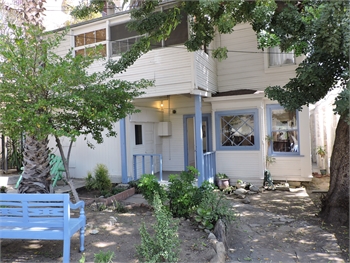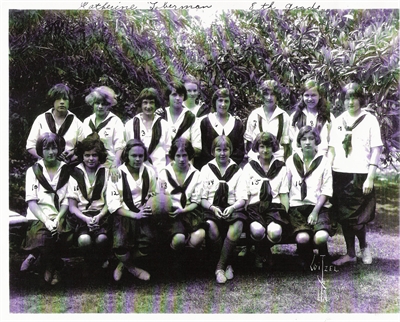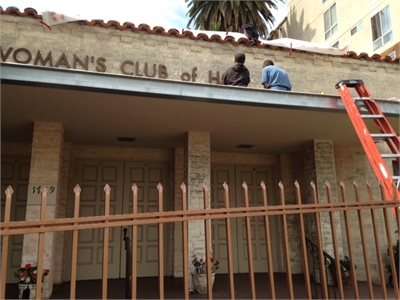The Hollywood School for Girls at Woman’s Club of Hollywood
One of the best kept secrets in Hollywood is a two-storey wooden house that was once the Hollywood School for Girls. At the rear of the Woman’s Club of Hollywood property at 1749 N. La Brea Avenue, the school house began life as a private residence. The house was built for Charles Hanchett and his wife in 1903—the year Hollywood was incorporated.
 In 1909, Miss Sophie Hogan was principal of a new school: The Hollywood School for Girls, situated on Sunset Boulevard and Hay Street. But in 1915, Charles Hanchett leased his two-storey home at 1749 N. La Brea to Miss Hogan as the new campus for the Hollywood School for Girls. Miss Hogan then sold her interest in the school to Miss Louise Knappen, a teacher from Minneapolis.
In 1909, Miss Sophie Hogan was principal of a new school: The Hollywood School for Girls, situated on Sunset Boulevard and Hay Street. But in 1915, Charles Hanchett leased his two-storey home at 1749 N. La Brea to Miss Hogan as the new campus for the Hollywood School for Girls. Miss Hogan then sold her interest in the school to Miss Louise Knappen, a teacher from Minneapolis.
As Principal, Miss Knappen lived in the upstairs of the house and the ground floor became the heart of the new school. Five smaller classrooms—or cottages—were built around the property. It was advertised as “An Outdoor School” because of the lush green lawns, flowers everywhere, acacia and pepper trees, rose gardens and jacaranda along the winding pathways. Classes were set up under the trees, even in a tree-house. For students from kindergarten to high school, HSG offered tuition in Latin, English, French, Mathematics, Domestic Science, Art, Music and Sports. It had around 100 girls and eventually 12 boys—with a few boarders, who slept on the sleeping porches during the heat of the summer. There was additionally a five-week Summer Session of limited classes from the start of July. Hollywood School for Girls quickly became one of the leading private schools in Los Angeles.
Principal Louise Knappen married architect William Woollett in 1917 and they made their home away from the school grounds. According to records, associate Principal Marjorie Knappen, a housekeeper, a secretary, a couple of teachers and a housemother lived on the property—in the main schoolhouse and in the ‘cottage’ classrooms.
 The school was known for its ‘casual’ atmosphere and attracted daughters of many of the early Motion Picture Industry pioneers. Cecil B. DeMill’s girls Cecilia and Katherine and their cousins Agnes and Margaret, Louis B. Mayer’s daughter Irene, Ruth Lasky—Jesse Lasky’s niece, and the daughters of Edgar Rice Burroughs, actors Francis X. Bushman and Reginald Denny were students. Catherine Toberman, daughter of Hollywood Developer C.E. Toberman and Mary Pickford and Douglas Fairbanks’ son, Douglas Jr. attended, as did actor Joel McRae. The most famous student was Harlean Carpenter, who became Jean Harlow. She was elected vice-president of her 8th-grade class in 1924.
The school was known for its ‘casual’ atmosphere and attracted daughters of many of the early Motion Picture Industry pioneers. Cecil B. DeMill’s girls Cecilia and Katherine and their cousins Agnes and Margaret, Louis B. Mayer’s daughter Irene, Ruth Lasky—Jesse Lasky’s niece, and the daughters of Edgar Rice Burroughs, actors Francis X. Bushman and Reginald Denny were students. Catherine Toberman, daughter of Hollywood Developer C.E. Toberman and Mary Pickford and Douglas Fairbanks’ son, Douglas Jr. attended, as did actor Joel McRae. The most famous student was Harlean Carpenter, who became Jean Harlow. She was elected vice-president of her 8th-grade class in 1924.
The French teacher was Edith Head, who also became the school’s art teacher. During the long summer break, Edith Head applied for a job as a sketch artist in the costume department at Paramount Studios. But, as she could not sketch, she had the students in her class provide the sketches she took to the interview. Edith Head went on to earn 35 Oscar Nominations and won Oscars for Roman Holiday, All About Eve, The Sting and many others.
By now, Louise Knappen Woollett had bought the school property from the original owner’s widow, Mrs. Charles Hanchett, and remained Principal until the school closed in 1932, after effects from the Great Depression and other influences resulted in the Woolletts being unable to keep up the loan payments. During the following years, the property became an Artists’ Colony, wherein painters, photographers, potters and other artists rented the school classrooms or cottages.
In 1945 the Woman’s Club of Hollywood bought the property. The Woman’s Club was founded in 1905, when 14 women decided Hollywood needed a library. They brought books from home and rented a room, until Dale Carnegie provided $10,000 and Daeida Wilcox gave them the piece of land on Ivar and Hollywood Boulevard where they built the library that still exists today. The members ran it until they donated it to the city of Hollywood. The members rented an outdoor venue for their music recitals in Daisy Dell. Eventually that became the Hollywood Bowl. The Club members banded together with other women in the community and started the annual Hollywood Bowl Easter Sunrise Service, which was run out of the Club office until its demise in 2010.
The Club worked with Ginger Rogers’ mother, Lela Rogers, Betty Davis and other powerful Hollywood women to build the Hollywood Studio Club, where young actresses coming to town to pursue acting careers had somewhere safe to live. The club members supported the Los Angeles Orphans’ Society and a wing of Hollywood Hospital, amongst other causes. All before they had the right to vote! The Woman’s Club original home was built in 1914 on Hollywood Boulevard at La Brea—where the four silver statues now stand. This clubhouse was the Red Cross Center during World War One and World War Two, when members sat alongside nurses rolling bandages and preparing things for those on the battle fronts.
But by 1945 Hollywood Boulevard was getting crowded, and the present premises expensive to run. So the Woman’s Club moved up the street to the country-like atmosphere of the old Girls’ School property at 1749 N. La Brea Avenue. In 1947 the club built the current clubhouse on the front of the school property, where the playing fields had been. Designed by noted architect Arthur Harvey in a Spanish-revival style, the clubhouse was built around the old two-storey schoolhouse and opened in 1949. Charlie Chaplin was involved in the club’s early days and played the piano that stands on the stage of today’s clubhouse. Mary Pickford was popular at the club and presented many of the cups awarded at the elaborate flower shows and parades from those early days. The club held regular fund-raising luncheons and lectures. Celebrities hosting or attending luncheons included Joan Crawford, Gary Cooper, poet W.B. Yeats and Gloria Swanson. In recent years, Tippi Hedren, Marsha Hunt, Doris Roberts, Steve Allen and Jayne Meadows, Tim Allen, Melanie Griffiths are among the celebrities attending the club.
 The club has just emerged from a lengthy battle with schemers, who attempted to turn the club into a luxury condo resort. But the members fought back and their clubhouse was returned to them—stripped of signs, furniture, fittings and fixtures. This is happening all over the country: women’s clubs that own property, and where members were aging, have become targets for these predatory take-overs.
The club has just emerged from a lengthy battle with schemers, who attempted to turn the club into a luxury condo resort. But the members fought back and their clubhouse was returned to them—stripped of signs, furniture, fittings and fixtures. This is happening all over the country: women’s clubs that own property, and where members were aging, have become targets for these predatory take-overs.
But this Hollywood Woman’s Club is a survivor. With a growing, younger membership and a new Board of Directors, the club is making a grand re-entrance into Hollywood. With a focus on the Golden Years of Hollywood, regular exciting events are happening. The recent Jean Harlow Celebration was so successful that this will become an annual event. With generous help from supporters, the restoration of the clubhouse and the schoolhouse are underway. The WCH is a California Cultural Heritage Monument (no. 604) and on the National Historic Registry.
As a 501c3 non-profit organization, the club continues to support The Jeffrey Foundation (for Mothers of Children with Special Needs), the Aviva Family Services, The Hamburger Teen Home, Make-Overs-That-Matter for veterans, returning veterans from all military fields and wherever else the help is needed.
And so a new chapter begins at this historic landmark. Since 1905 the Club had been the Heart of Hollywood—and 112 years later, the Woman’s Club of Hollywood has found her heart again. DH